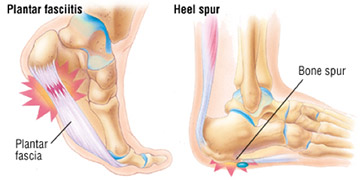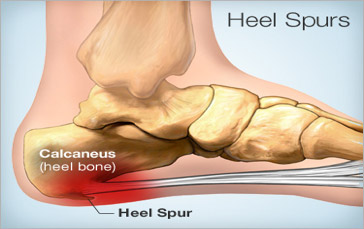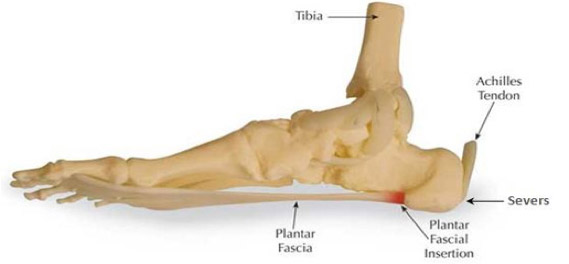Plantar fasciitis
Plantar fasciitis is a painful condition where the plantar fascia of the foot has been traumatised. The plantar fascia is a flat band of tissue under the foot that spans from the heel to the bottom of your toes. In its healthy state, the plantar fascia is strong and resilient enough to support the arch of the foot without causing any pain. Under some circumstances, however, it may be inflamed.
The underlying cause of plantar fasciitis is often excessive subtalar joint pronation. Excessive subtalar joint pronation results in lowering of the arch on the inside of the foot (the medial longitudinal arch). This causes the foot to elongate and may increase tractional (pulling) forces on the plantar fascia. This in turn causes irritation of the origin of the plantar fascia at the heel, resulting in pain.

(From: http://www.drugs.com/health-guide/heel-pain.html)

(From: http://www.webmd.com/pain-management/heel-spurs-pain-causes-symptoms-treatments)
In addition to plantar fasciitis, some patients may also develop a heel spur. A heel spur is a bony growth, usually occurring at the front of the heel bone (Calcaneus). It is important to understand that not all heel spurs cause pain. The addition of a heel spur to plantar fasciitis usually does not change the management plan.
Symptoms of plantar fasciitis
Most people with plantar fasciitis experience heel pain with their first steps when rising from bed in the morning or simply when standing after long periods of sitting. It normally presents a sharp stabbing pain at the bottom or front of the heel. It usually subsides after a while and may turn into a dull ache.

(From: http://plantarfasciitis.com.au/)
Factors that contribute to the development of heel pain
Unsupportive footwear
Some people require external factors such as footwear to provide additional support to their foot. This is particularly the case in people with excessive foot pronation.
Increasing activity too quickly
A rapid change in the intensity or frequency of activity may place unaccustomed structures within the foot, such as the plantar fascia, at an increased risk of injury.
Body mass
People who are overweight or obese have more force transferred through their foot and its supporting structures. Therefore, more stain is placed on them.
Occupation
Standing or walking for long periods increases the strain on supporting structures in the foot and may lead to fatigue of these structures and therefore potential injury.
Age
Increasing age can reduce the integrity of supporting structures in the foot, potentially increasing their risk of injury.
Pregnancy
A transient increase in weight can suddenly overload structures within the foot, increasing the strain on them and increasing their risk of injury.
Treatment of plantar fasciitis
Plantar fasciitis is a complex condition that often requires tailored treatment that should be developed in consultation with a Health Professional. There are a range of treatment options available such as:
Relative rest
Reducing activities that aggravate the condition may help.
Heat or ice pack
This largely depends on the stage of the condition being experienced. Generally, ice packs can be helpful in the acute stage whereas heat packs may be helpful in the chronic stage.
Weight loss
This should be an aim for the long term when the pain has been treated.
Stretching exercises
Stretching of tight calf muscles may help. Stretching of the plantar fascia before standing has been shown to help reduce first step pain.
Remedial massage
Remedial massage may ease tension in tight muscles or other soft tissue structures in and around the foot that may be contributing to the development of plantar fasciitis.
Acupuncture
Research has shown that acupuncture may reduce inflammation while causing no adverse effect on the body. Acupuncture may provide some relief in patients with plantar fasciitis.
Footwear
Worn-out footwear has a reduced ability to provide support therefore new footwear can help. In addition, advice from a Podiatrist regarding the most appropriate shoe for you may help.
Orthotic shoes / thongs
Orthotic insoles, shoes and orthotic thongs can provide a cost-effective, long-term solution to controlling excessive foot pronation therefore reducing the pain associated with plantar fasciitis.
